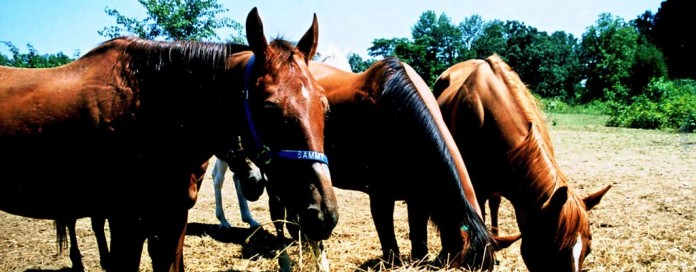URBANA, Ill. — Up to 80 percent of young horses in some breeds develop osteochondritis dissecans — a disease in which the cartilage at the end of long bones, such as bones in the leg, fails to develop normally, according to Dr. Annette McCoy, an equine surgeon at the University of Illinois Veterinary Teaching Hospital in Urbana.
Although any breed of horse may be affected, Standardbreds and Warmbloods are considered to be predisposed to osteochondritis dissecans.
Joints affected
Any joint can be affected. The joints most commonly affected in horses are the fetlock, hock, and stifle.
It is not uncommon to have bilateral disease, meaning in the same joint is affected in both the right and left legs. It is less common, however, to have multiple joints in the same leg affected.
What factors contribute to the risk of developing osteochondrosis is the subject of Dr. McCoy’s research. Environment (including such factors as diet, exercise, and biomechanics) and genetics each play a role in disease development.
Dr. McCoy is conducting a study that examines how biomechanical differences in gait—pacing vs. trotting may interact with genetic traits to affect the risk of developing osteochondrosis in Standardbreds.
Genetic factors
Genetic factors are thought to account for one-fourth to one-half of the disease risk. Some studies have shown that large body size, copper deficiency, high phosphorus intake relative to calcium intake, and irregular exercise are environmental factors associated with osteochondrosis in horses.
However, study results are not clear-cut, in part because there are so many interactions among risk factors.
So what is a horse owner to do to limit the risk of this disease?
“The recommendation for owners is to feed a balanced diet, with appropriate mineral ratios and micronutrients, at a level to support consistent moderate growth, and to allow regular, moderate exercise on even ground,” advises McCoy. “Even with the best management, it is likely some foals will still develop osteochondritis dissecans because of genetic factors.”
The most common clinical sign is joint effusion, meaning too much fluid in the joint, especially soon after the horse has been put to work. Occasionally horses may show a mild lameness, but many horses that are diagnosed with this disease do not have any clinical signs.
McCoy says that osteochondritis dissecans is usually diagnosed using X-rays to detect fragments in the joint. Ultrasound and fluoroscopy, an imaging method that uses X-rays to see movement in real time, may also be used in making a diagnosis.
Both legs
When osteochondritis dissecans is identified in one joint, the same joint in the other leg should be checked as well since bilateral disease is common.
“When osteochondritis dissecans is seen in a foal that is less than six months old, X-rays should be re-taken when the horse is older to confirm the problem. In very young foals the problem may heal spontaneously,” said McCoy. “In horses older than 11 months, problems noted on X-rays should be considered permanent and treatment should be recommended.”
Small fragments of bone or cartilage may be left in place and treated conservatively with anti-inflammatory drugs in the joint. However, for the majority of cases, surgical removal of the fragments using arthroscopy is recommended.
Occasionally, surgeons may attempt to reaffix very large fragments to the bone rather than remove them. After a surgical procedure, the horse will require careful attention to the surgery site and strict stall rest for the first two weeks.
Exercise may be increased gradually. Anti-inflammatory medications may be recommended four weeks after surgery.
Generally the horse may return to normal exercise after six weeks.
According to Dr. McCoy, most racehorses and sport horses are able to return to athletic work after surgery. In cases where very large fragments were found or where cartilage damage was observed in the joints, the outcome may be less favorable.
For more information about osteochondritis dissecans in horses, speak with your equine veterinarian.










